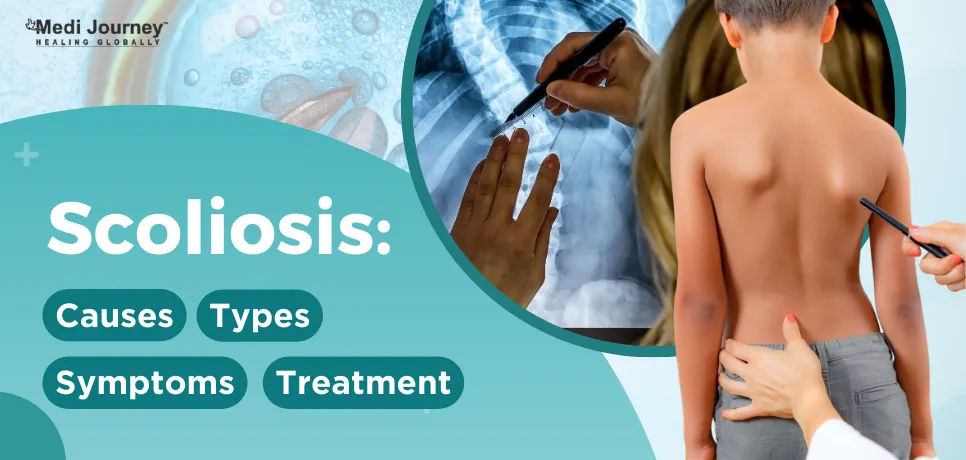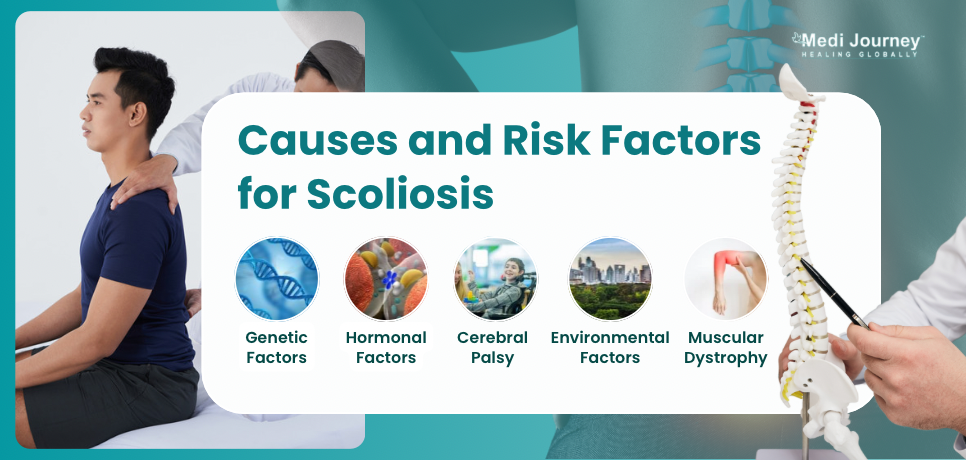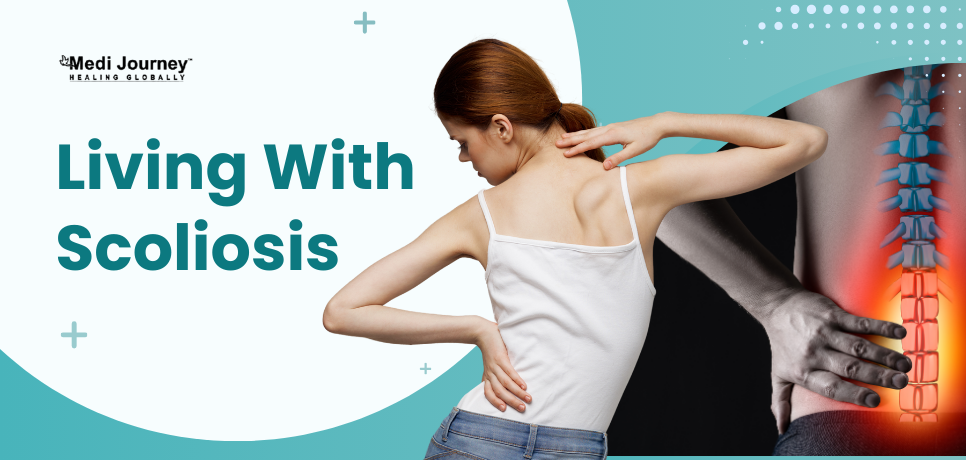Best Liver Transplant Surgeons in Artemis Hospital Gurgaon
 24 December,2025
Read More
24 December,2025
Read More
Enquire now in case of any assistance needed

Did you know that an estimated 2% to 3% of the population lives with scoliosis, a condition that twists the spine into an unnatural curve? That's millions of people worldwide experiencing the often-invisible challenges of this spinal deformity. From the playground to the workplace, scoliosis can impact every aspect of life.
Let's shed some light on this condition and discover how to straighten out the facts. From understanding the different types to exploring treatment options and coping strategies, we’ll uncover everything you need to know about scoliosis.
Fill up the form and get assured assitance within 24 hrs!
Scoliosis is a diseased condition characterized by an abnormal lateral curvature of the spine. Unlike the natural curves in the thoracic, lumbar, and cervical regions of the backbone, scoliosis involves a side-to-side curvature that often appears as a "C" or "S" shape when viewed from the back. This condition can vary significantly in severity, from mild cases that may go unnoticed to severe deformities that can cause significant health issues and require intervention.
Scoliosis can develop at any age but is most commonly diagnosed in adolescents and children during their growth years. This condition can affect individuals differently, with some experiencing only mild discomfort while others may endure chronic pain and physical limitations. The impact of scoliosis is not solely physical; it can also have psychological and social implications, particularly for young individuals who may feel self-conscious about their appearance.
The spine's normal alignment includes gentle curves that help absorb shock and support the body's weight. In scoliosis, however, the vertebrae rotate and form a curved spine, disrupting the body's balance and alignment. This abnormal curvature can lead to uneven shoulders, waist, and hips, affecting posture and gait.
The diagnosis of scoliosis often begins with a physical examination, where a healthcare provider looks for signs of asymmetry in the shoulders, waist, and back. If scoliosis is suspected, imaging tests such as X-rays, MRIs, or CT scans help confirm the diagnosis and evaluate the severity of the curvature.
Learning about scoliosis is essential for early detection and management. While the exact cause of scoliosis is difficult to find, various factors, including genetics, neuromuscular conditions, and congenital abnormalities, can contribute to its development. Recognizing the signs and symptoms of scoliosis early on can lead to timely intervention, preventing the condition from worsening and improving the individual's quality of life.
Scoliosis can be divided into several types based on its underlying cause and the age at which it develops. Understanding the different types of scoliosis is crucial for accurate diagnosis and effective treatment. The primary types of scoliosis include idiopathic, congenital, neuromuscular, and degenerative scoliosis.
Idiopathic scoliosis (IS) is the most common type, accounting for ~80% of all scoliosis cases. The word "idiopathic" means that the exact cause of the disease is unknown. Idiopathic scoliosis is further subdivided based on the age of onset:
Congenital scoliosis (CS) is present at birth and results from spine malformations during fetal development. These malformations can include:
Neuromuscular scoliosis (NS) occurs due to underlying neuromuscular disorders that affect the muscles and nerves responsible for supporting the spine. Common conditions associated with neuromuscular scoliosis include:
Degenerative scoliosis (DS), also known as adult-onset scoliosis, typically occurs in individuals over 45 years of age. It is caused by the degeneration of the spinal discs and joints due to aging. Factors contributing to degenerative scoliosis include:
Syndromic scoliosis is associated with various syndromes and genetic disorders, such as Marfan syndrome, Ehlers-Danlos syndrome, and neurofibromatosis. Each condition has its own set of characteristics and complications that can contribute to the development of scoliosis.
Identifying the type of scoliosis is essential for determining the appropriate treatment plan. While some types of scoliosis, such as idiopathic scoliosis, may not have a clear cause, understanding the underlying factors in other types can guide treatment strategies and improve outcomes for affected patients.

Recognizing the signs of scoliosis is crucial for early diagnosis and effective management. Scoliosis can manifest in various ways depending on the severity and type of curvature. Common signs and symptoms include visible physical deformities, pain, and functional impairments.
The most noticeable sign of scoliosis is an abnormal curvature of the spine. The abnormal curvature can result in visible physical deformities such as:
While mild scoliosis may not cause significant pain, more severe cases can lead to discomfort and pain in various parts of the body:
Scoliosis can also impact an individual's daily life and physical abilities:
The visible deformities and physical limitations associated with scoliosis can have a significant psychological and social impact, particularly for children and adolescents:
Accurate diagnosis of scoliosis is essential for determining the appropriate treatment plan and preventing complications. Spine surgeons use a combination of physical examinations, imaging tests, and other diagnostic methods to assess the severity and progression of scoliosis. Early detection and monitoring are vital for effective management.
The initial step in diagnosing scoliosis often involves a thorough physical examination. Healthcare providers look for visible signs of scoliosis and assess the patient's posture and alignment. Key components of the physical examination include:
Imaging tests are essential for confirming the diagnosis of scoliosis, assessing the severity of the curvature, and monitoring progression. Standard imaging tests include:
The Cobb angle is the standard measurement to quantify the degree of spinal curvature in scoliosis. It is determined using X-ray images and involves the following steps:
The Cobb angle helps classify the severity of scoliosis:
A scoliometer is a handheld device that measures the angle of trunk rotation (ATR). It is a simple and non-invasive tool that helps assess the severity of scoliosis during a physical examination. The patient bends forward, and the provider places the scoliometer on the back to measure the rotation angle. While not as precise as an X-ray, the scoliometer is helpful for initial screenings and monitoring changes over time.
Genetic testing may be conducted in suspected congenital or syndromic scoliosis cases to identify specific genetic mutations or syndromes associated with spinal deformities. It provides valuable information necessary for diagnosis, prognosis, and treatment planning.
Depending on the type and severity of scoliosis, additional assessments may be necessary:
Regular monitoring and follow-up are essential for managing scoliosis, particularly during periods of rapid growth. Doctors, particularly spine surgeons, use a combination of physical examinations and imaging tests to track the progression of the curvature and make informed decisions about treatment.
Early diagnosis and ongoing monitoring are crucial for effective management of scoliosis. By using a combination of diagnostic methods, healthcare providers accurately assess the severity of the scoliosis and develop personalized treatment plans to improve outcomes for affected individuals.

The causes of scoliosis are diverse and can vary depending on the type of scoliosis. While the exact reason for idiopathic scoliosis remains unknown, other forms of scoliosis can be attributed to specific factors. Understanding the causes and risk factors for scoliosis is crucial for identifying at-risk individuals and executing preventive measures where possible.
The most common type, idiopathic scoliosis, has no known cause. However, several theories suggest that a combination of environmental, hereditary, and hormonal factors may contribute to its development.
Congenital scoliosis is caused by malformations of the spine during fetal development. These malformations can result from genetic mutations, environmental factors, or a combination of both:
Neuromuscular scoliosis is associated with underlying neuromuscular conditions that affect the muscles and nerves supporting the spine. Common causes include:
Degenerative scoliosis, or adult-onset scoliosis, typically occurs in older individuals. It is due to the natural aging process. Causes and risk factors include:
Several risk factors are linked to increase the likelihood of developing scoliosis:
While not all cases of scoliosis can be prevented, early detection and timely intervention can help manage the condition and prevent complications. Proactive monitoring and early intervention are essential for individuals with known risk factors, such as a family history of scoliosis or neuromuscular conditions.
Understanding the causes and risk factors for scoliosis is important for healthcare providers, parents, and individuals at risk. Recognizing the factors contributing to scoliosis makes it possible to implement preventive measures, ensure early detection, and provide timely treatment to improve outcomes and quality of life for those affected by this condition.
Scoliosis treatment depends on multiple factors, including the severity of the curvature, the patient's age, and the type of scoliosis. The foremost goal of scoliosis treatment is to prevent curve progression, reduce pain, and improve function and appearance. Treatment options range from observation and bracing to surgical interventions, each tailored to the patient's individual needs.
Observation is often recommended for individuals with mild scoliosis, mainly when the curvature is less than 20 degrees. In these cases, regular monitoring is essential to track any changes in the curvature. This approach is most commonly used in children and adolescents who are still growing, as well as in adults with mild scoliosis that is not causing significant symptoms.
During observation, patients undergo physical examinations and periodic X-rays to assess the curve's progression. If the curvature remains stable, no further treatment may be necessary. However, if the curve worsens, other treatment options may be considered.
Bracing is a standard treatment for moderate scoliosis, particularly in children and adolescents with curves between 20 and 40 degrees. It prevents further progression of the curvature during growth and is most effective when started early and worn consistently as prescribed.
There are several types of braces used in scoliosis treatment:
It is worth noting that bracing does not correct the existing curve but can help prevent it from worsening. The effectiveness of bracing depends on factors such as the type of scoliosis, the severity of the curve, and patient compliance with wearing the brace.
Physical therapy and exercise play a supportive role in the management of scoliosis. While these may not prevent curve progression, they can help improve strength, flexibility, and overall function. Physical therapy programs for scoliosis often include:
Specific scoliosis exercise programs, such as the Schroth method, focus on customized exercises that address each patient's unique curvature pattern. These programs can complement other treatments and improve quality of life.
For individuals with scoliosis-related pain, pain management strategies may include:
Surgery is typically advised for severe cases of scoliosis, particularly when the curve exceeds 40 to 50 degrees or when the condition causes significant pain, functional impairment, or respiratory issues. The most common surgical procedure for scoliosis is spinal fusion.
Recovery from scoliosis surgery involves a period of rehabilitation to ensure optimal outcomes. Physical therapy and exercise are crucial to recovery, helping patients regain strength, flexibility, and function. Pain management and regular follow-up appointments are also vital to monitor the success of the surgery and address any complications.

Living with scoliosis presents unique challenges that can affect various aspects of daily life. While the condition can be effectively managed with appropriate treatment and lifestyle adjustments, individuals with scoliosis often need to adopt coping strategies for physical, emotional, and social impacts.
Maintaining good physical health and mobility is crucial for individuals with scoliosis. Regular exercise and physical therapy help improve strength, flexibility, and posture. Incorporating activities such as swimming, yoga, and Pilates can be beneficial, as these exercises promote spinal alignment and overall fitness without placing excessive strain on the spine.
Managing pain is a significant aspect of living with scoliosis. Chronic pain significantly impacts daily activities and quality of life. Strategies for pain management include:
Maintaining a good posture is essential for individuals with scoliosis to reduce discomfort and prevent further curvature. Postural awareness can be improved through:
The visible physical deformities and chronic pain associated with scoliosis can lead to emotional and psychological challenges, such as reduced self-esteem, anxiety, and depression. These issues can be managed by:
Scoliosis can also affect social interactions and educational experiences, particularly for children and adolescents:
Family members and caregivers play a crucial role in supporting individuals with scoliosis. Assisting with daily activities, Providing emotional support, and encouraging adherence to treatment plans can make a significant difference in managing the condition. Open communication and education about scoliosis can help families navigate the challenges together.
Scoliosis is a lifelong condition that requires ongoing management. Regular follow-up appointments with healthcare providers are essential for monitoring the progression of the spinal curvature and adjusting treatment plans as needed. Staying vigilant and informed about the latest research and treatment options can also empower scoliosis patients to make informed decisions about their care.
Living with scoliosis requires adaptation and resilience. While the condition can present challenges, many individuals with scoliosis lead fulfilling and active lives. They can navigate their condition and achieve their goals by focusing on self-care, seeking support, and maintaining a positive outlook.
Understanding the multifaceted impact of scoliosis and adopting a holistic approach to management can help individuals with scoliosis live well and thrive. With the proper support and resources, it is possible to overcome the challenges posed by scoliosis and enjoy a high quality of life.
Scoliosis is a complex condition characterized by abnormal spine curvature. While it can present significant challenges, understanding the different types, recognizing the signs and symptoms, and exploring the various causes and risk factors are essential for effective management. Early detection and appropriate treatment, ranging from observation and bracing to surgical interventions, can prevent progression and improve outcomes.
Living with scoliosis requires a comprehensive approach that addresses physical, emotional, and social aspects. Regular exercise, pain management, postural awareness, and emotional support are crucial for well-being. With the right strategies and support, individuals with scoliosis can lead fulfilling lives and achieve their goals despite the challenges posed by the condition.
Fill up the form and get assured assitance within 24 hrs!
Doctor of Pharmacy
Dr. Deepanshu Siwach is a skilled clinical pharmacist with a Doctor of Pharmacy degree.?He has 4+?years of experience and has worked with thousands of patients. He has been associated with some of the top hospitals, such as Artemis Gurgaon.
A renowned Neuro-spine Surgeon, Dr. S K Rajan, has successfully performed over 3000 surgeries, including intricate spine cases. With over 25 years of experience, his expertise lies in minimally invasive (keyhole) spine surgery, Craniovertebral junction (...
Senior Consultant
Medical Oncologist
Nanavati Super Specialty Hospital, Mumbai
WhatsApp UsSenior Director
Gynecologist and Obstetrician, IVF Specialist
Max Super Speciality Hospital, Shalimar Bagh, New Delhi
WhatsApp UsSenior Director
Gynecologist and Obstetrician, IVF Specialist
Max Smart Super Speciality Hospital, Saket, New Delhi
WhatsApp UsSenior Director
Gynecologist and Obstetrician
Max Smart Super Speciality Hospital, Saket, New Delhi
WhatsApp UsSenior Director
Gynecologist and Obstetrician
Max Smart Super Speciality Hospital, Saket, New Delhi
WhatsApp UsSenior Director
Gynecologist and Obstetrician
Max Smart Super Speciality Hospital, Saket, New Delhi
WhatsApp UsThe Art of Effective Communication
 24 December,2025
Read More
24 December,2025
Read More
 23 December,2025
Read More
23 December,2025
Read More
 17 December,2025
Read More
17 December,2025
Read More
 16 December,2025
Read More
16 December,2025
Read More
 10 December,2025
Read More
10 December,2025
Read More
 09 December,2025
Read More
09 December,2025
Read More
Trusted by Patients
"I am Asim from Bangladesh and was looking for treatment in India for neuro. I visited many websites to get the complete information regarding the treatment but I was not satisfied as I was getting confused. In the meanwhile, one of my friends suggested I seek help from Medi Journey as he experienced his medical journey very smoothly and was satisfied with it. They have filtered the top 10 doctors as per experience, the success rate of surgery & profile, so it helps us to choose the best treatment in India. "
"For my knee surgery, Medi Journey guided me to BLK Hospital where I received exceptional care. The team's support and the expertise at BLK Hospital exceeded my expectations. Thank you Medi Journey for making my medical journey stress-free. "
"I came from Iraq for my granddaughter's eye surgery in India facilitated by Medi Journey, due to critical cases they advised us to get a second opinion from the different hospitals before going to surgery. Finally, we went to Fortis Escort Hospital, which helped us to get more confidence for diagnosis. Fortis Escort Hospital has the best eye surgeon team with the latest instruments. Thanks to all team members for providing a high-quality treatment in India at an affordable cost. "
"I came for my hair transplant in India, before coming I was so confused about choosing the best clinic and surgeon for me. But thanks to God one of my friends had a hair transplant in India through Medi Journey. He recommended me to go with them. I am completely happy with my experience with them. They were always very fast in their responses to me. the success rate of my hair transplant surgery is 100%."
"Artemis Hospital, suggested by Medi Journey, turned out to be a great choice for my treatment. The personalized assistance and medical care were exceptional. I'm grateful to Medi Journey for guiding me to a hospital that perfectly matched my needs. Highly recommended! "
"I came from Afghanistan for my treatment in India at Jaypee Hospital, Noida. I had a fantastic experience with Medi Journey. Kudos to them for their incredible support during my medical journey. They not only took care of all the logistics but also connected me with a fantastic healthcare team. Efficient, caring, and highly recommended for a hassle-free medical tourism experience."
"I am Adam from Kano, Nigeria, one of my friends from Nigeria was facilitated by Medi Journey, and he recommended us to go with them. I sent my all reports to them and within 48 hours they reverted with 4 options from different hospitals. They helped me to get a Visa letter from the hospital, arrange pick-up from the airport, and book a hotel for me. Their team is very honest and throughout our stay in India they are with us they are caring for us like his family members. BLK Hospital is the best hospital in India with a top surgical oncologist surgeon team, a very advanced OT, and a Radiotherapy department. I wish more success to Medi Journey. "
"Great experience at the Max Hospital for my spine surgery and was successfully done. I thank my neurosurgeon and his entire team. I recommended all of my country's people to Medi Journey for treatment in India, they choose the best hospital, the best doctors, and the best cost for patients."
"I came to India from Dhaka, Bangladesh for my father-in-law's cardiac surgery at Fortis Hospital. I was confused about choosing the best surgeon for him before coming, but their team helped me to choose the best hospital and best cardiac surgeon in India with very good cost and 100% success rate of surgery. I am very happy with the services, really they make my journey so comfortable that make me feel at home. Thanks again and I like people to choose "Medi Journey" as your travel guide. "
"I am Mohammad from Bangladesh came to India for my general health checkup. Medi Journey offers me the complete package including Pick-up from the airport, hotel services, and 24-hour assistance. They guide you to choose the best hospital in India, the best cost of treatment with top-most doctors and give you complete information about hotel booking, and pick-up from the airport before coming to India They have the best team to help. Always choose Medi Journey for your treatment in India."





